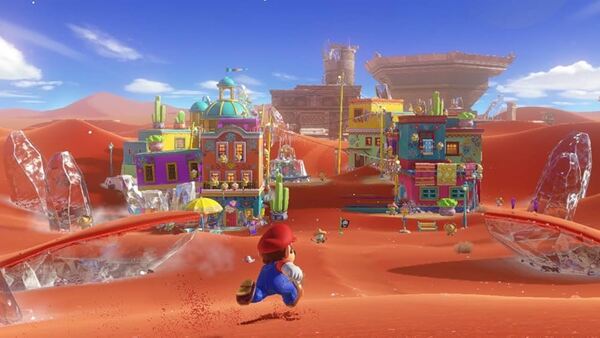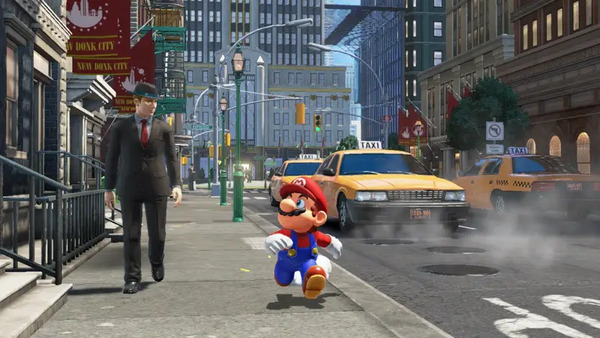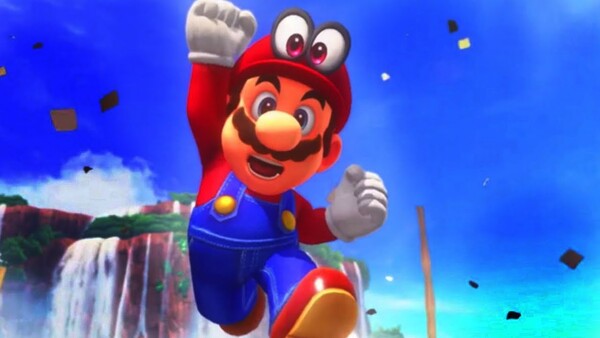Introduction
Super Mario Odyssey is one of Nintendo’s flagship titles, celebrated for its creative level design, captivating gameplay mechanics, and delightful art style. The game follows Mario as he travels across various kingdoms, aided by his sentient hat, Cappy, in a quest to rescue Princess Peach from Bowser. While the game has received widespread acclaim for its technical aspects and world-building, one specific issue has remained a point of discussion: the representation of gender and the roles of the characters, particularly in terms of their dynamics and portrayal. This article will examine how
Super Mario Odyssey presents gender roles, how it continues the legacy of gender representation in the Mario franchise, and the broader cultural implications of its character choices. Despite its joyous and whimsical tone, there are deeper questions regarding the roles of women and the gender dynamics within the game that are worth exploring.

1. The History of Gender Representation in the Mario Franchise
1.1 Early Gender Roles and Mario’s Legacy
From the inception of the Mario franchise, gender roles have been defined primarily through stereotypical lenses. Princess Peach, as the damsel in distress, is a key figure in many of the early Mario games, portraying the helpless female character who needs saving by the male protagonist. Mario, on the other hand, is almost always the hero who rescues Peach, positioning him as the dominant force in the narrative.
1.2 Evolving Roles in Later Games
Over time, there have been shifts in how female characters are portrayed, especially as more emphasis has been placed on representation in video games. Princess Peach has been featured in roles that break her initial mold as a helpless damsel, particularly in games like
Super Princess Peach, where she embarks on her own adventure. However,
Super Mario Odyssey still reflects much of the older dynamics, with Peach largely relegated to the role of the ‘damsel,’ despite the advances in the series’ broader narrative.
2. Princess Peach’s Role in Super Mario Odyssey
2.1 A Damsel or a Leader?
In
Super Mario Odyssey, Princess Peach is once again the target of Bowser’s unwanted affection, with Mario set to rescue her. However, while she does play a central role, the game largely falls into the traditional trope of the woman in need of saving. Although Peach is not passive, as she does show some agency by rejecting Bowser’s marriage proposal, she remains caught in a scenario where she needs to be rescued by Mario, reinforcing the notion of traditional gender roles.
2.2 Peach's Agency and the Moon Kingdom
At the end of the game, Peach chooses not to return with Mario or Bowser but instead remains independent. This decision is significant in that it gives Peach a sense of autonomy, offering her a rare moment of independence. Still, her overall role in the game can be seen as one that centers on male characters' need to rescue or compete for her attention, which leaves her autonomy somewhat muted.
3. Cappy: The Feminization of Mario’s Sidekick?

3.1 Cappy's Role as a Support Character
Cappy, Mario’s sentient hat, is introduced as an integral character in
Super Mario Odyssey. While Cappy offers new mechanics and gameplay depth, it’s important to examine the ways in which Cappy can be seen as a feminized figure. Cappy, with its ability to take over the bodies of other creatures, becomes a passive vehicle for Mario’s needs, supporting his actions throughout the game. This dynamic, in some ways, reinforces the traditional notion of passive female characters serving as support for the active male protagonist.
3.2 Cappy’s Relationship with Mario
Cappy also stands as a foil to Mario’s character, offering a more sensitive and empathetic perspective in certain interactions. Cappy’s longing to reunite with his sister, Tiara, who has been kidnapped by Bowser, provides a subplot that’s emotionally grounded. This emotional vulnerability, combined with Cappy’s less aggressive actions compared to Mario, brings attention to how the game subtly portrays masculinity and femininity in a traditionally male-centered game.
4. The Female Characters in Super Mario Odyssey: A Limited Presence
4.1 The Few Women in the Game
While
Super Mario Odyssey features a diverse range of characters from different kingdoms, female characters are notably underrepresented. Most of the non-playable characters are either male or anthropomorphic creatures. The few women present, such as the female rulers of various kingdoms, are often relegated to secondary roles, with limited agency or depth. For example, in the Sand Kingdom, the ruler, the Queen, appears in a limited context and plays a small role in the larger narrative.
4.2 The Absence of Prominent Female Heroes
One of the starkest issues in the game is the absence of a prominent female protagonist. While Peach does take part in the game’s finale, it is ultimately Mario who is tasked with the hero’s journey. The game presents no female characters who take up a central active role in advancing the plot, which further perpetuates the absence of strong, playable female characters in the Mario universe.
5. The Implications of Male-Centric Power Dynamics

5.1 Mario as the Undisputed Hero
In
Super Mario Odyssey, Mario remains the undisputed hero throughout the game, reinforcing traditional masculine ideals of strength, courage, and independence. This unchallenged heroic status often overshadows the potential for the development of other characters, especially female ones. While Mario’s heroic status is central to the plot, the lack of a meaningful challenge to this role from other characters, including women, limits the narrative’s scope regarding gender dynamics.
5.2 Bowser’s Role as the Villain
Bowser’s role as the villain is another important aspect of the game’s gender dynamic. His obsession with marrying Princess Peach, despite her clear disinterest, is a classic representation of toxic masculinity—asserting control over a woman’s autonomy through force. However, the portrayal of Bowser as a villain in the game, although traditional, also reinforces the contrast between “good” (Mario) and “bad” (Bowser) masculinity. This dynamic positions the game as heavily focused on traditional male archetypes.
6. The Impact of Cappy’s Gendered Representation
6.1 Cappy as an Extension of Mario's Identity
The fact that Cappy is a gender-neutral character initially complicates the notion of gender representation, yet there are still subtle cues that suggest a feminization of Cappy. With Mario’s reliance on Cappy to possess and control other creatures, Cappy, like Peach, functions as an extension of Mario’s desire to conquer. However, because Cappy is not fully autonomous—relying on Mario’s control—it suggests that even the game's support characters may be limited by gendered expectations.
6.2 Gender Fluidity and the Impact of Cappy
Cappy’s ability to possess various creatures might offer a subversion of gender roles. As Mario and Cappy traverse various kingdoms, they take over different creatures, some male and some female, suggesting a fluidity in gender roles. However, this fluidity does not extend to the central narrative, where Mario remains the sole active figure with Peach and other women relegated to passive or supportive roles.
7. The Role of Female Characters in the Post-Game Content
7.1 Post-Game Unlockables and Peach’s Agency
After completing the main quest, players can unlock additional content in
Super Mario Odyssey, including the opportunity to control Princess Peach in specific mini-games. While this allows Peach to take on an active role, it’s still secondary to the primary storyline. The limited nature of this content reinforces the notion that female characters in the Mario universe are often pushed to the periphery, even when presented with potential for greater involvement.
7.2 Is There Room for Growth?
While Peach does take part in the game's conclusion, her ultimate role is one of non-involvement. If Nintendo wishes to continue developing its characters, offering stronger, more active roles for women could provide a more balanced dynamic and greater representation. This would not only expand the narrative but also present a fresh perspective on the franchise.
8. The Cultural Impact of Gender Representation in Video Games
8.1 Gender Stereotypes in Gaming
Super Mario Odyssey is part of a larger trend in gaming that still heavily relies on gender stereotypes. These traditional gender roles are evident in many blockbuster titles and often go unquestioned. However, the evolution of characters like Princess Peach hints at a growing awareness of the need for change. Video games have immense cultural influence, and how they portray gender dynamics affects real-world perceptions of gender roles.
8.2 How Can Video Games Evolve?
As gaming becomes a more diverse and inclusive medium, franchises like Mario have an opportunity to evolve and reflect a more progressive view of gender representation. By creating female protagonists who are just as capable and central to the plot as their male counterparts, game developers can challenge traditional norms and provide better representation for players of all genders.
9. Mario's Relationship with Gender and Gender Roles
9.1 Masculinity and the Hero’s Journey
Mario's consistent portrayal as the hero who must “save the girl” represents the archetypal masculine role in many forms of media. While the franchise has attempted to diversify Mario’s role in some games,
Super Mario Odyssey still predominantly aligns with traditional gender expectations. Exploring new narratives where gender roles are more flexible could significantly impact the future direction of Mario games.
9.2 What’s Next for Gender Representation in the Mario Franchise?
Looking forward,
Super Mario Odyssey may set the stage for more nuanced portrayals of gender within the Mario universe. Although Peach’s character remains primarily passive, the game’s final moments suggest that a shift towards more active female representation could be on the horizon. Future titles may give more voice and agency to female characters, breaking away from the stereotypical damsel in distress.
10. Conclusion
Super Mario Odyssey is undoubtedly an incredible game that has captured the hearts of players around the world, but it is also a product of its time, reflecting the longstanding gender dynamics of the Mario franchise. While it shows some signs of progression, with Princess Peach making a choice for her own independence and Cappy breaking certain gender norms, the game largely upholds traditional gender roles. Moving forward, there is great potential for the series to diversify its representation of characters, offering a more balanced portrayal of gender. In doing so, it could contribute to the ongoing conversation about gender equality and representation in video games.





















